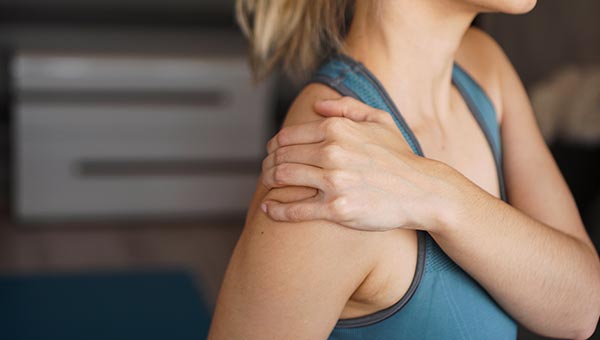Shoulder and elbow pain are common and can have a number of different causes. If you suffer shoulder trauma or elbow trauma, such as a fracture or dislocation, you are likely to experience sudden, severe pain. Such acute pain often occurs in sports injuries.
Shoulder impingement, tendonitis, rotator cuff tears, frozen shoulder and arthritis are also common causes of shoulder pain and elbow pain. If you have elbow stiffness it can affect the way you use your whole arm. Elbow problems may be caused by an injury or conditions like tendonitis, bursitis and arthritis, which can lead to chronic pain. Despite its name, tennis and golfer’s elbow do not just affect sportspeople but anyone who repetitively bends and flexes the elbow joint (such as painters and decorators).

Common shoulder and elbow conditions
Our specialists treat all types of conditions affecting the shoulder and elbow including:
ACJ injuries/dislocations
The acromioclavicular joint is where your collarbone meets your shoulder blade. You can injure/dislocate it by falling heavily onto your shoulder or as a result of a direct blow. In some cases, surgery may be required.
Arthritis (osteoarthritis)
Arthritis is a degenerative disease caused by the loss of cartilage that normally covers the tops of the bones helping them slide smoothly over each other. Over time the bones may start to rub together, and bony spurs may form, causing pain, swelling and loss of movement.
Biceps injuries
The biceps tendon attaches the biceps muscle to the shoulder and elbow bone. It may become torn at the shoulder if you fall hard onto your outstretched arm or lift something too heavy. Overuse injuries can also occur, particularly with repeated overhead motions, as in tennis.
Clavicle fractures
The clavicle is your collarbone. It may fracture if you fall heavily onto your shoulder or an outstretched arm or receive a direct blow to the shoulder. It can be very painful and prevent you from using the affected arm.
Frozen shoulder
Frozen shoulder is when your shoulder becomes stiff and immobile and very painful to move. The precise causes are not clear, but it can be linked to injury or surgery that prevents you from moving your arm, or diabetes. Untreated, the condition may last for several years.
Pectoralis major injuries
The pectoralis major is a powerful muscle that is used to move the shoulder forwards and across the chest. It may become ruptured during weight training or other strenuous activities. A serious injury may require surgical repair or tendon graft.
Rotator cuff injuries
The rotator cuff is a group of muscles and tendons that surround the shoulder joint, holding the head of the upper arm bone in the shoulder socket. Injuries occur more commonly with age and among people whose jobs involve making repeated overhead movements, such as painters.
Shoulder and elbow fractures
Fractures to the shoulder and elbow are usually caused by some kind of trauma, such as a fall or direct impact. Many can be treated without surgery, but some may not heal properly without surgical intervention or carry an increased risk of arthritis.
Shoulder impingement
Shoulder impingement is where a tendon inside the shoulder joint rubs or catches on nearby tissue or bone when you move your arm. It is a common cause of shoulder pain. It may improve with exercise or steroid injections, but sometimes decompression surgery may be needed.
Shoulder instability or dislocation
The shoulder is the most mobile joint in the body and may dislocate if the head of the upper arm bone is forced out of the shoulder socket. Once this has happened you may experience repeated dislocations, called chronic shoulder instability.
Sports injuries and trauma
Because the shoulder is the most mobile joint in the body it is particularly prone to sports-related injuries, such as SLAP tears, rotator cuff tears and shoulder instability.
Tennis/golfer's elbow
Tennis and golfer’s elbow are both forms of epicondylitis, or inflammation of the tendons that attach to the elbow caused by overuse. Tennis elbow affects the outside of the elbow whereas golfer’s elbow affects the inside.
Ulnar nerve entrapment
The ulnar nerve is one of the three main nerves in your arm. It can become compressed behind the inside part of the elbow, or at the wrist or collarbone. This is called entrapment.
Read about private shoulder and elbow treatment at Harley Street Specialist Hospital



